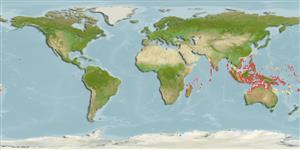Teleostei (teleosts) >
Gobiiformes (Gobies) >
Gobiidae (Gobies) > Gobiinae
Etymology: Trimma: Greek, trimma, -atos = something crushed (Ref. 45335).
More on author: Herre.
Environment: milieu / climate zone / depth range / distribution range
Ecology
Marine; reef-associated; depth range 20 - 30 m (Ref. 9360). Tropical
Indo-West Pacific: Philippines to Australia (Ref. 2334). Reported from Maldives (Ref. 11303).
Size / Weight / Age
Maturity: Lm ? range ? - ? cm
Max length : 3.0 cm TL male/unsexed; (Ref. 2334)
Dorsal spines (total): 6 - 7; Dorsal soft rays (total): 9; Anal spines: 1; Anal soft rays: 8. Characterized by purplish body color with six red-orange stripe on head and anterior body; second dorsal spine usually elongate and filamentous; fifth pelvic ray branched, 60-70% length of fourth ray; longitudinal scale series 26-27; predorsal scales absent; cheek and opercle without scales; depth of body about 4.0 in SL (Ref. 90102).
Solitary or in small groups (Ref. 90102). Usually lives in caves and crevices of outer reef slopes (Ref. 2334). Inhabits deep lagoon and protected seaward reefs (Ref. 37816).
Life cycle and mating behavior
Maturity | Reproduction | Spawning | Eggs | Fecundity | Larvae
Randall, J.E., G.R. Allen and R.C. Steene, 1990. Fishes of the Great Barrier Reef and Coral Sea. University of Hawaii Press, Honolulu, Hawaii. 506 p. (Ref. 2334)
IUCN Red List Status (Ref. 130435: Version 2024-1)
Threat to humans
Harmless
Human uses
Fisheries: commercial; aquarium: commercial
Tools
Special reports
Download XML
Internet sources
Estimates based on models
Preferred temperature (Ref.
123201): 26.4 - 28.5, mean 27.8 °C (based on 58 cells).
Phylogenetic diversity index (Ref.
82804): PD
50 = 0.5000 [Uniqueness, from 0.5 = low to 2.0 = high].
Bayesian length-weight: a=0.01023 (0.00477 - 0.02194), b=3.01 (2.83 - 3.19), in cm total length, based on LWR estimates for this (Sub)family-body shape (Ref.
93245).
Resilience (Ref.
120179): High, minimum population doubling time less than 15 months (Preliminary K or Fecundity.).
Fishing Vulnerability (Ref.
59153): Low vulnerability (10 of 100).
Nutrients (Ref.
124155): Calcium = 339 [155, 981] mg/100g; Iron = 1.65 [0.75, 3.40] mg/100g; Protein = 18.2 [16.1, 20.0] %; Omega3 = 0.17 [0.06, 0.44] g/100g; Selenium = 31.5 [11.1, 78.9] μg/100g; VitaminA = 104 [24, 441] μg/100g; Zinc = 3.86 [2.21, 6.17] mg/100g (wet weight);
